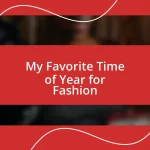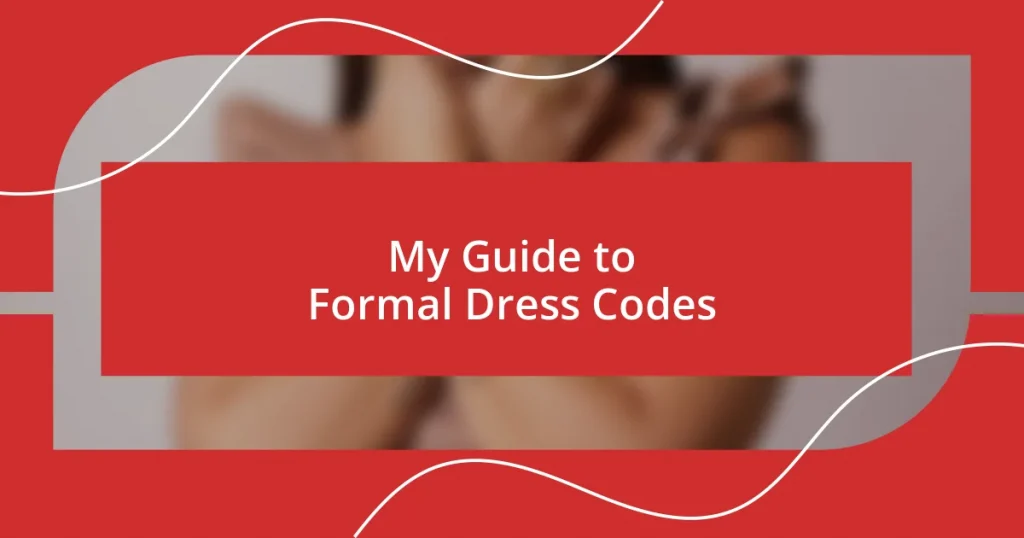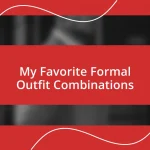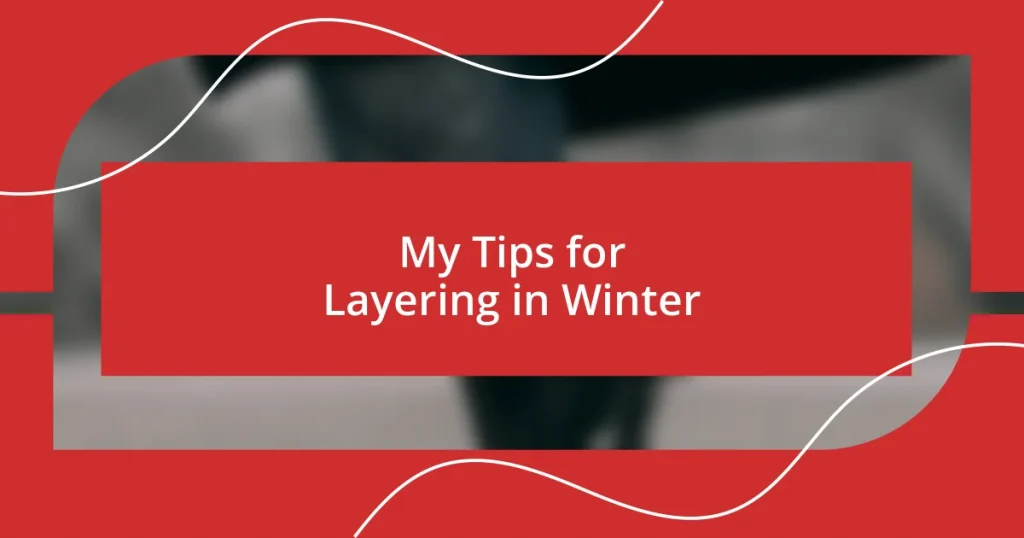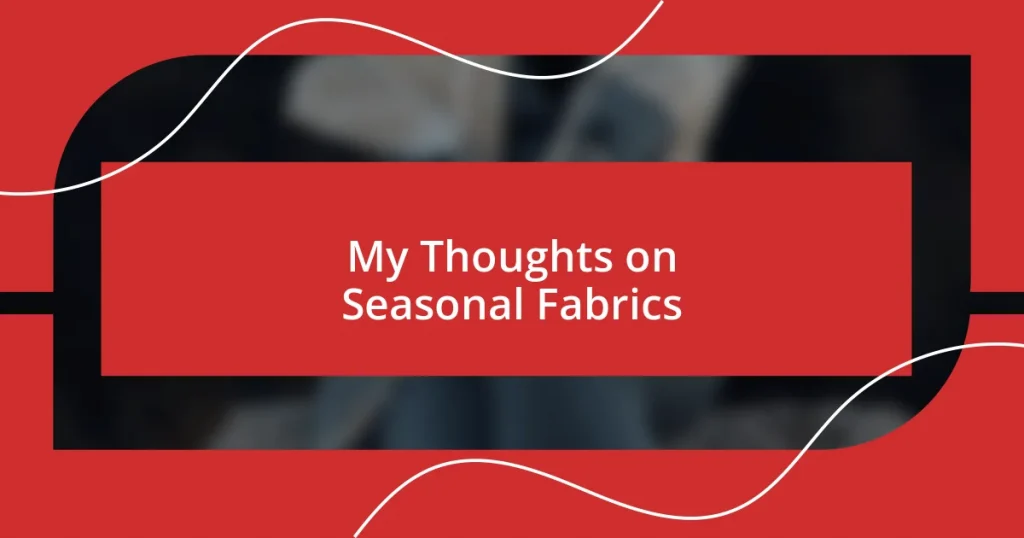Key takeaways:
- Understanding dress codes, such as black tie and white tie, is essential for making appropriate outfit choices and feeling confident at formal events.
- Key elements of formal attire include fit, fabric, color, accessories, and footwear, all of which impact overall appearance and confidence.
- Balancing personal style with tradition and prioritizing comfort in formal wear are crucial for making a memorable impression and enjoying the occasion.
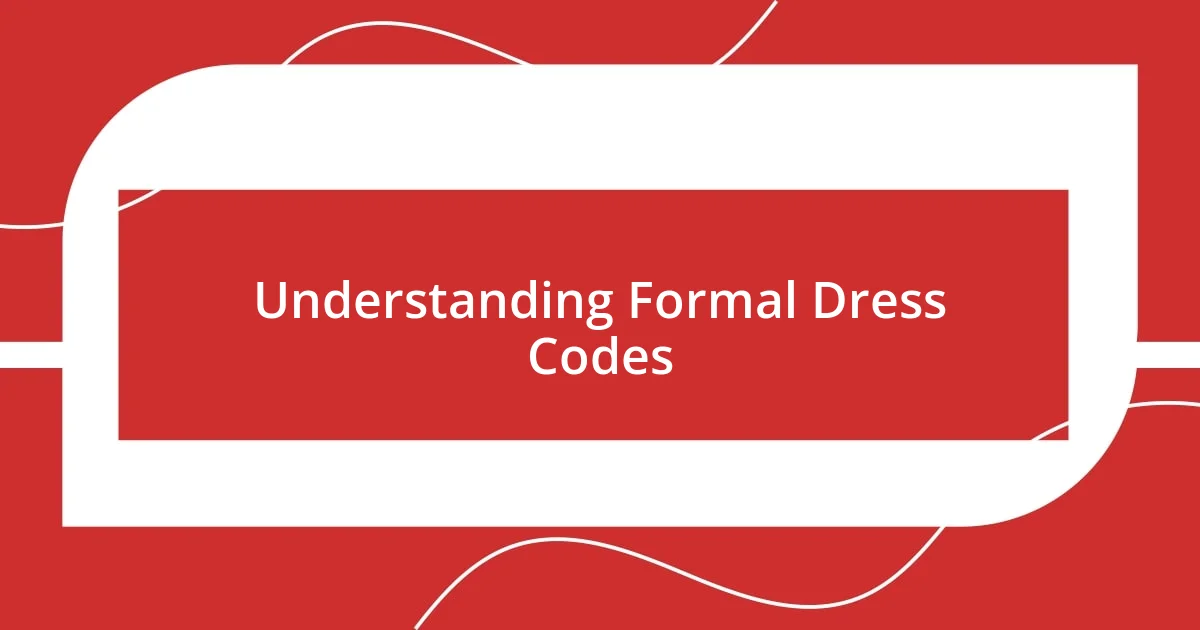
Understanding Formal Dress Codes
Formal dress codes can often feel intimidating, but I see them as a way to express respect for the occasion. I remember attending a wedding where the invitation specifically asked for black tie, and I felt a rush of excitement planning my outfit—nothing like slipping into a well-tailored suit to feel confident and sophisticated. Have you ever experienced that thrill of dressing up? It can elevate your mood and set the tone for the event.
Understanding the nuances of formal attire can truly transform your experience. For instance, the distinction between “black tie” and “white tie” is subtle yet significant—while a black tie look calls for a tuxedo, white tie requires even more refinement, like a tailcoat and formal waistcoat. I once mixed them up at a gala; it taught me how important it is to clarify these details ahead of time.
When you grasp the importance of dressing appropriately, it opens a door to deeper connections with others at events. I remember feeling more at ease mingling at a corporate event when I realized everyone else was equally committed to making a good impression. Isn’t it fascinating how clothing can bridge those initial gaps between strangers?
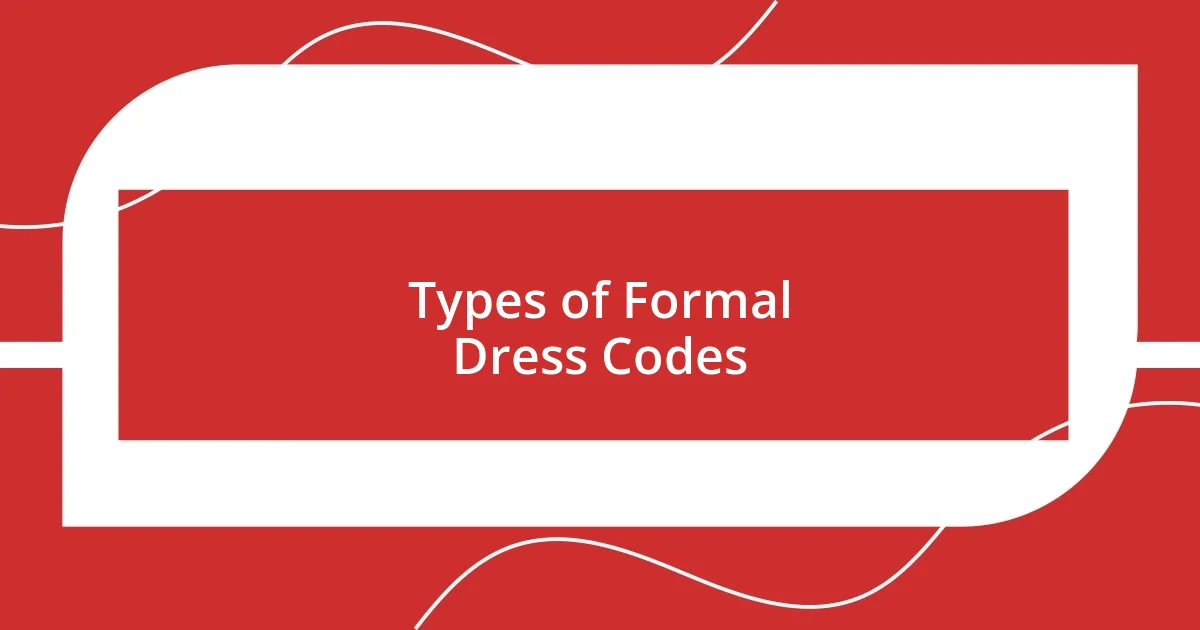
Types of Formal Dress Codes
Understanding the various types of formal dress codes can significantly enhance your confidence in any setting. For example, when I received an invitation for a cocktail party, I was taken aback at first, unsure of what “cocktail attire” really meant. After doing some research, I learned it strikes a balance between formal and casual—think of a sleek dress or a stylish blazer paired with smart trousers. It was a revelation that made me appreciate the guidance provided by dress codes.
Another common type is “business formal,” which always seems to be the go-to for corporate events. It’s the category where I learned that sticking with tailored suits and professional dresses can make all the difference during important meetings. I remember nailing my presentation dressed in a sharp navy suit; it not only boosted my confidence but also signaled to my colleagues the level of seriousness I was bringing to the table. Have you ever felt how the right outfit can influence your performance?
Finally, we have “creative black tie.” This is where you can have a little fun while still remaining polished. When I attended a themed charity gala, I chose a vibrant bowtie to add a pop of color to my classic tuxedo. It was liberating to see how my unique personal touch resonated with others, fostering a playful yet sophisticated atmosphere at the event. Isn’t it incredible how different types of formal dress codes provide distinct opportunities to express yourself?
| Dress Code | Description |
|---|---|
| Black Tie | Tuxedo, bow tie, and black formal shoes. |
| White Tie | Tailcoat, formal waistcoat, and dress shirt. |
| Cocktail Attire | Smart dresses or suits that strike a balance between formal and casual. |
| Business Formal | Tailored suits or professional dresses for corporate events. |
| Creative Black Tie | Formal wear with a personal and creative twist. |
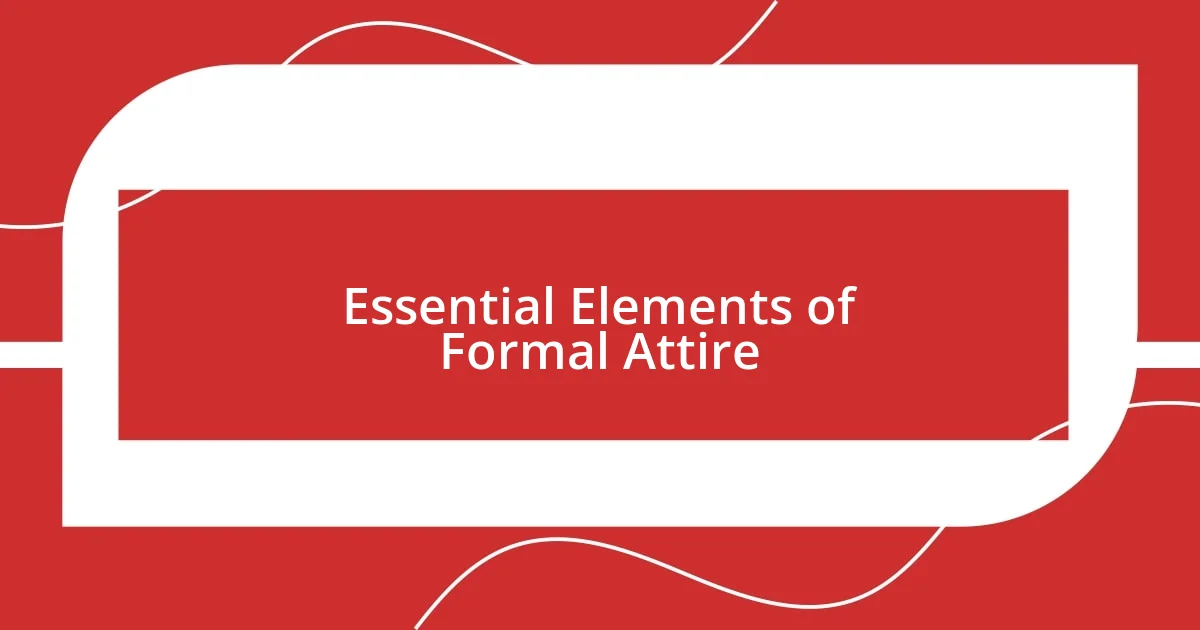
Essential Elements of Formal Attire
Understanding the essential elements of formal attire can feel like decoding a secret language, but I find it quite rewarding once you get the hang of it. For me, the right choice of fabric can elevate an outfit significantly; I still recall the luxurious feeling of a wool tuxedo I wore to a charity gala. The way it draped and moved with me added an air of sophistication that helped me navigate those formal conversations with ease.
Here’s a quick breakdown of the key elements to keep in mind:
- Fit: Tailoring is essential for a polished look; it should complement your body shape.
- Fabric: Quality materials like silk, wool, and linen not only look good but also feel more comfortable.
- Color: Stick with classic colors such as black, navy, or deep burgundy for a timeless appearance.
- Accessories: A tasteful tie, pocket square, and cufflinks can add flair without being overpowering.
- Footwear: Polished shoes are non-negotiable; they tie the look together, so I always invest in a good pair.
Each of these elements plays a crucial role in making sure you look and feel your best, enhancing your confidence at any event. When I focus on these details, I can’t help but notice how it creates a ripple effect in my interactions; people respond differently when they see someone who has put thought into their appearance.
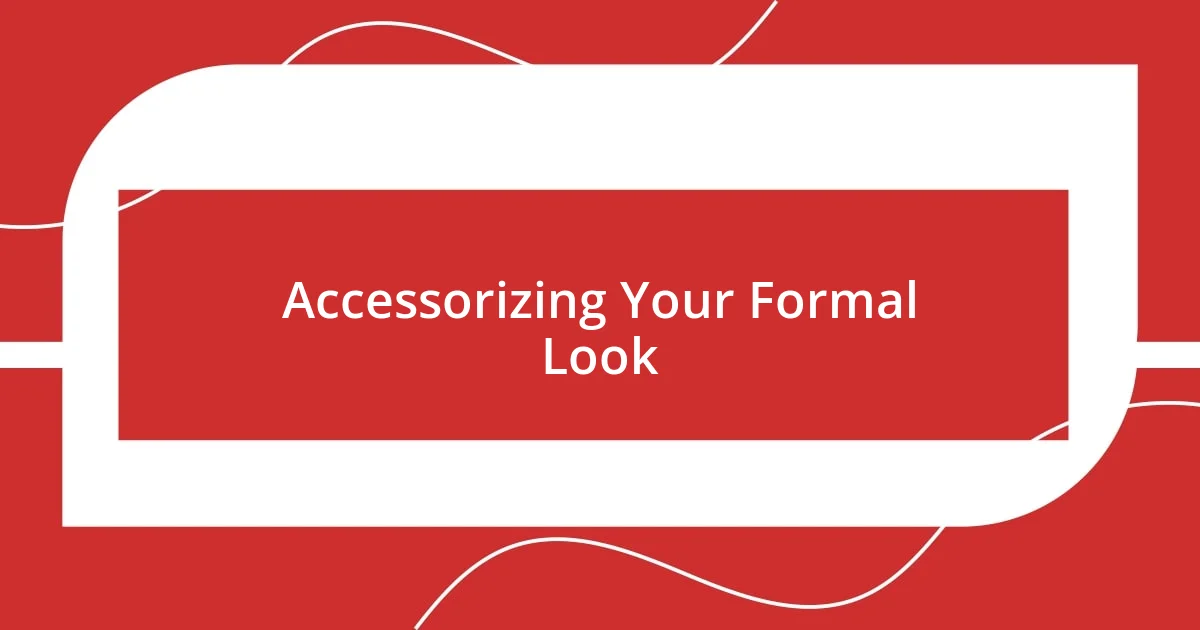
Accessorizing Your Formal Look
Accessorizing your formal look can be a game-changer in expressing your personal style while adhering to the occasion’s expectations. I remember attending a formal wedding where I decided to experiment with accessories. I chose a striking tie and a coordinating pocket square, both adding a sophisticated flair that received compliments all night. It felt rewarding, as if those thoughtful touches truly showcased my personality amidst the formal setting.
It’s fascinating how the right accessories can transform your outfit entirely. Have you ever felt that rush of confidence when you catch a glimpse of yourself in the mirror? When I added a classic wristwatch to my ensemble for a gala, I noticed how it not only completed my look but also served as an icebreaker for conversations. The subtle elegance of that watch drew people in, prompting questions about its story, which helped me connect with others more effortlessly.
Don’t underestimate the power of shoes in formal attire, either. I once made the mistake of wearing a pair that, while comfortable, simply did not match the overall elegance of my suit at a networking event. The lack of coordination stole some of my confidence that night, reminding me how essential it is to let every aspect of your outfit sing in harmony. By investing time and thought into your accessories, you truly accentuate your formal wear and, ultimately, your self-assurance.
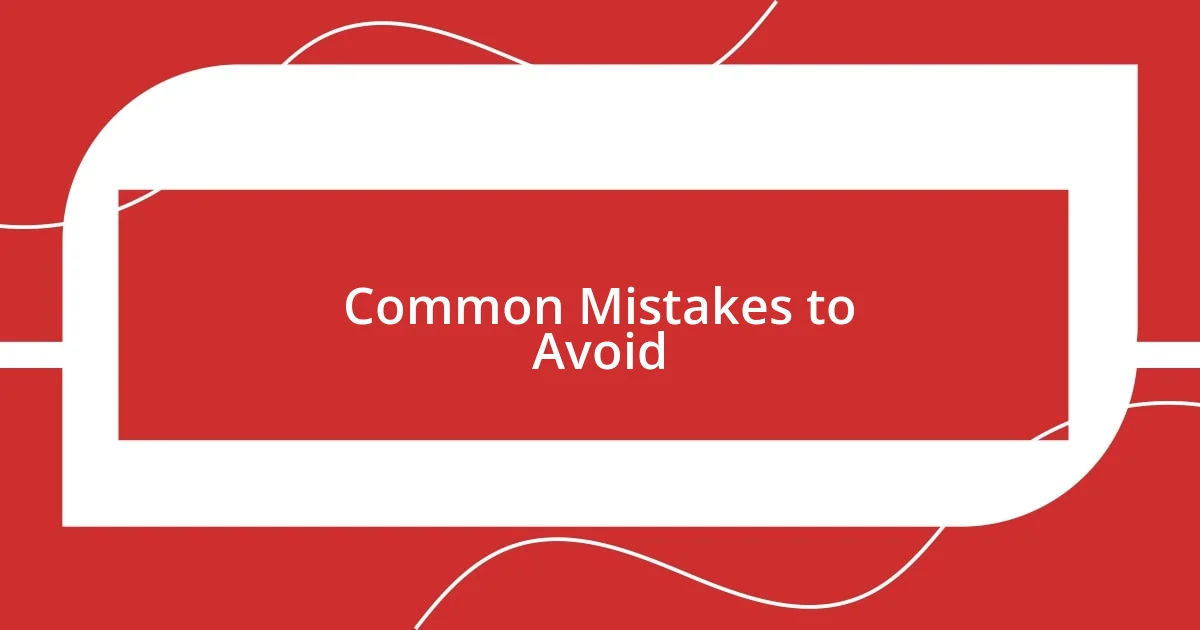
Common Mistakes to Avoid
One common mistake I see often is underestimating the dress code itself. I once found myself in a black-tie event wearing a dark suit instead of a tuxedo, thinking I could get away with it. The moment I walked in and saw everyone else in their formal attire, I felt a pang of regret, realizing I hadn’t honored the occasion or myself. Understanding the nuance of the dress code is crucial; a little research can save you from that sinking feeling of being out of place.
Another pitfall is neglecting to consider the fit of your clothing. I had a friend who bought a stunning blazer online, full of anticipation, only to find it was too big when it arrived. He spent the entire evening tugging at the sleeves, which not only diminished his confidence but also made him look disheveled. Investing in alterations can make all the difference; well-fitted clothing speaks volumes about your attention to detail and respect for the occasion.
Lastly, don’t overlook your grooming! I made the mistake once of being so focused on picking the perfect outfit that I forgot to tidy my hair and polish my shoes. Walking into an event feeling polished top to bottom is vital; those simple grooming touches can elevate your entire appearance. When you feel fresh and put together, it not only shows but also uplifts your confidence, allowing you to engage with others more freely. So, ask yourself: are you presenting your best self at formal events?
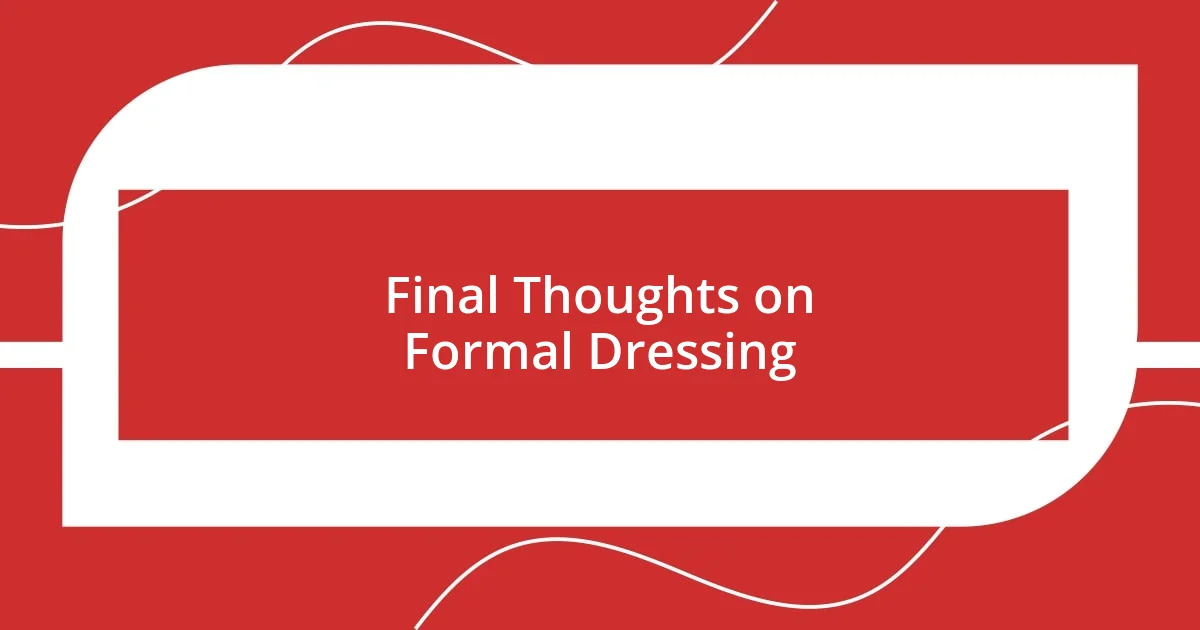
Final Thoughts on Formal Dressing
When it comes to formal dressing, I’ve found that confidence is just as important as the clothes themselves. I vividly remember the first gala I attended where I felt completely out of my element. As I stood there, adjusting my tie nervously, I realized that the way I carried myself mattered just as much as my attire. Have you ever noticed how some people seem to light up a room? It’s not just about the outfit—it’s about attitude.
Another key factor in my experience has been the balance between tradition and personal style. At a formal event last year, I wore a unique cummerbund instead of the traditional waistcoat. Admittedly, I was anxious, wondering if it would come across as too casual. Yet, the compliments I received assured me that being true to who I am—even within the confines of formal dress—can create a memorable impression. Have you considered how your unique flair might enhance your formal look?
Lastly, let’s not overlook the importance of comfort in formal wear. I recall one instance when I chose a pair of stunning yet painfully tight shoes for an important business dinner. By the end of the evening, I was focused more on my discomfort than on engaging in meaningful conversations. This taught me that while style is crucial, being comfortable allows you to truly engage and enjoy the moment. So, do you prioritize comfort when selecting formal attire, or do you sometimes sacrifice it for the sake of aesthetics?






